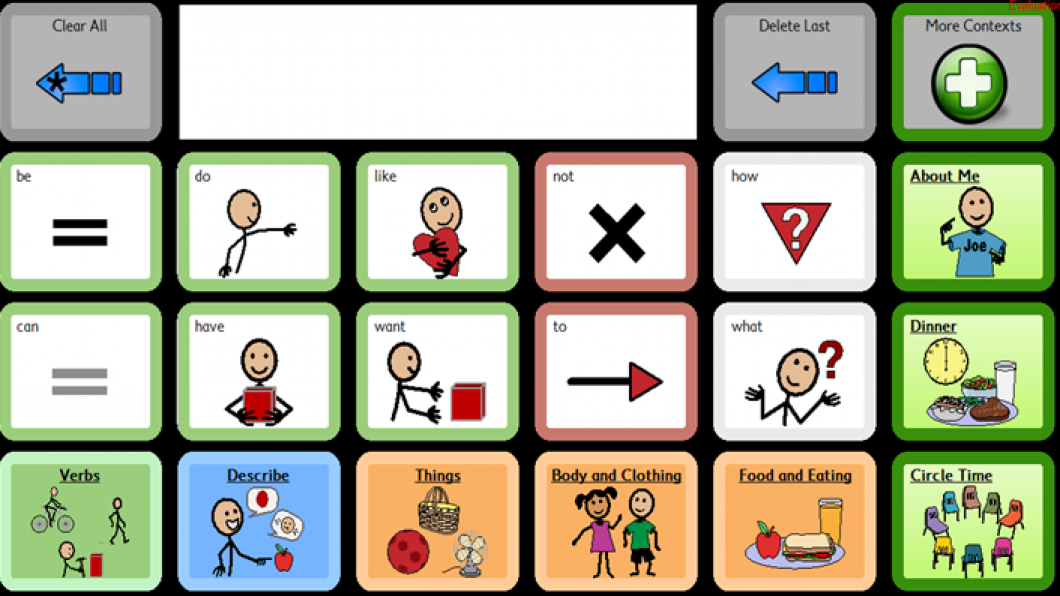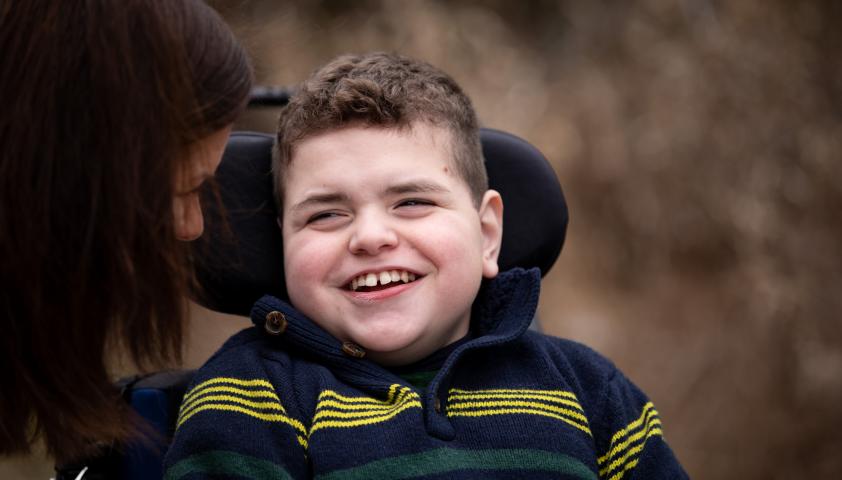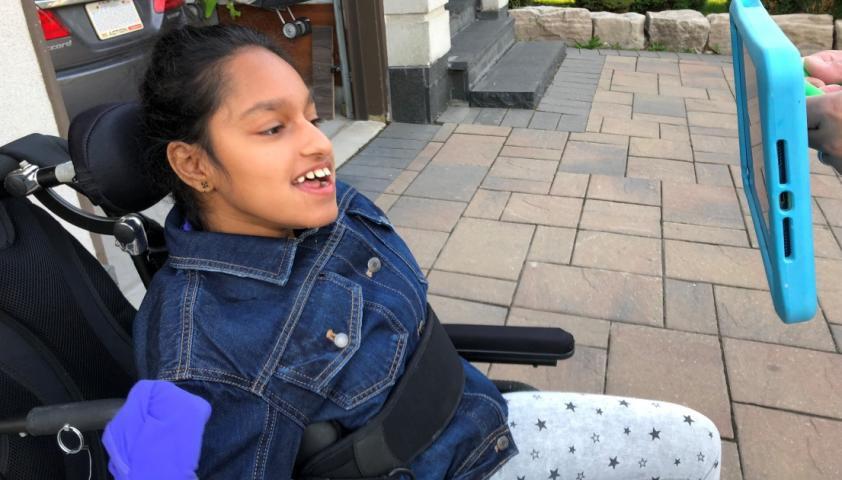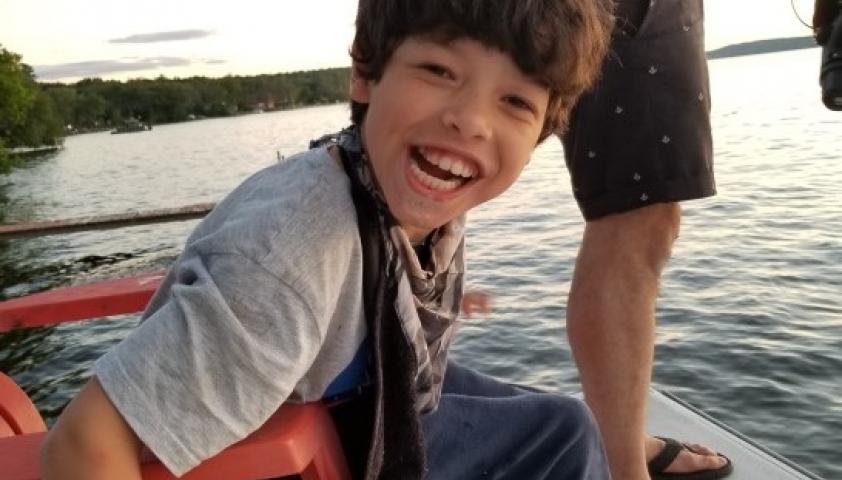
There’s more than one way to communicate
Communication in all of its forms is such a vital part of our being. It allows us to share our needs, wants, feelings, and thoughts. We share information, knowledge, and stories. It helps us build relationships. But, when many think of communication to-date, speaking is usually the first definition that comes to mind.
In reality, communication is so much more than speech.
Communication can involve the use of symbols, gestures, signs, writing, communication devices, music, art, social closeness, social media, electronic messaging, sounds, and so much more. Augmentative and Alternative Communication (AAC) are tools and strategies that make daily communication possible when there are challenges, and the Communication and Writing Aids Service (CWAS) at Holland Bloorview helps provide these.
After all there’s more than one way to communicate and these four amazing kids prove just how.

Meet Scarlet
How do you say “I love you?” A few months after 15-year-old Scarlet received her communication device, her mother Angela recalls how her daughter used her eye gaze to select a symbol on her speech-generating device to tell her that message.
Having those words said to her for the first time, Angela says, is almost as big as the first time Scarlet asked for a drink.
Scarlet received her device from Holland Bloorview’s CWAS last year. Since then, the family has worked with CWAS to help Scarlet use her eye gaze.
“It allows her to interact at mealtime. We always stop and have meals together. It’s a big deal that she can participate now,” says Angela. “It’s become quite helpful at school, she’s always asking questions, asking for things, participates in conversation, and we get to see her sense of humour come out.”
It’s a humour that shines through when Scarlet spends time with her family, goes for a swim, and especially when she asks her father to play guitar, while making fun of him at the same time.
She eye gazes “I love you,” though, to make up for it.

Meet John
Twelve-year-old John loves to swim, the outdoors—especially on windy days—and having stories read to him. And thanks to his Partner Assisted Auditory Scanning system (PAAS), his mother Anne Marie says he’s now able to share stories as well.
When John was 13-months-old, he fell ill with meningitis. For the next six weeks, he spent time at MacMaster Health Centre before spending the next seven months in Holland Bloorview’s Inpatient Brain Injury Rehabilitation Unit.
“Following his discharge, he continued with the day program, and soon Holland Bloorview became our second home,” says Anne Marie.
Over the years, John has participated in the summer respite camps, attended dentist appointments, participated at the school during two 8-week stays following hip surgeries, and visits the orthopedic clinics. He’s also a huge fan of the Snoezelen pool—the hospital’s quieter pool—and the therapeutic clowns.
“John’s PAAS has empowered him. It has given him a voice. He’s so proud when he’s able to communicate using his communication system,” says Anne Marie.
Now, according to his CWAS team, John communicates by making a sound to choose from a curated list organized in a book, with his choice then being spoken out loud by a partner who understands his book.
So when you ask John what his favourite things to do with his communication system are, he responds by choosing, “Make or tell stories, talk to your friends at school, tell us how you feel, and tell us what you want.”
Now John’s gift of being a storyteller has been unlocked.
“I will never forget the day he brought home the first story he told, from school,” she says. “He was so proud for me to read it back to him when he arrived home that day.”

Meet Oviya
When you ask Ramya to describe her 12-year-old daughter Oviya, she goes with the words fun-loving.
“She loves listening to music, going to the park to play on the swing, and conversing with her family and friends.”
For Oviya, conversing involves using a voice activated switch to navigate and select words and letters on her speech-generating device to build sentences. When asked how she feels about it, she uses her switch to respond with, “Excellent.”
“We were referred to Holland Bloorview by her school board for help with augmentative communication. Because of her fine motor delays she is unable to access a switch with her hands,” says Ramya. “Holland Bloorview helped get her a switch that she can access through her voice. She depends on her device and others to help her get around.”
Since then, the hospital has also been great for helping with device-related technical issues and providing an orthopedic surgeon.
“As a non-verbal child, Oviya was unable to engage in any meaningful way with the adults and peers around her. Since getting her device, she has been able to participate in our family conversations, as well as at school,” says Ramya.
“She was extremely limited in her ability to make herself understood without the communication device. There was so much frustration because of this. She is now a happy girl with a voice.”

Meet Joseph
"If you think I am here to talk to you about me then I should leave. I have a voice that works for me. I am here for all the voiceless people. Let me help you to find a way for everyone to find their voice. Communication is a human right.”
It’s the first thing 12-year-old Joseph communicated to employees at the company who manufactures his speech-generating device.
And it’s also something so ingrained in Joseph’s personality. He loves learning, joking around, asking difficult questions and trying to find new and better solutions.
According to his mother, Carolyn, he’s always been an animated communicator even before he got his voice.
“Joseph has been fortunate enough to have been given a voice that meets his basic needs but he is painfully aware that others do not,” says his mother, Carolyn.
“He wants to work with the companies that make speech-generating devices to consider the individual needs of communication partners and develop a system that can alter devices appropriately to better meet those individual needs.”
Before receiving his speech-generating device at the age of two, Joseph communicated through signs, gestures, and grunts.
It’s a device they discovered through CWAS at Holland Bloorview, where they’ve been deeply ingrained since Joseph’s pre-school days. And while Joseph has since moved on from his Bloorview School days, this CWAS connection is one that Carolyn and her husband value deeply, and one that has helped Joseph through his journey.
“My husband always melts when he remembers the first time Joseph called him dad using his device,” she says.
“Our main connection to Holland Bloorview is our amazing Communication Team at CWAS. They provide so much support and comfort to us as a family, as we continually search for a device that will supersede Joseph’s learning needs.”